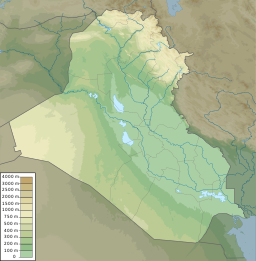Lake Milh
| Lake Milh | |
|---|---|
 From space, June 1996 | |
 Lake Milh | |
| Coordinates | 32°45′09″N 43°38′06″E / 32.75250°N 43.63500°ECoordinates: 32°45′09″N 43°38′06″E / 32.75250°N 43.63500°E |
| Type | Saline |
| Primary inflows | Canal from Lake Habbaniyah which comes from the Euphrates River |
| Primary outflows | Euphrates River |
| Basin countries | Iraq |
| Surface area | 1,562.34 km2 (603.22 sq mi) |
Lake Milh (Arabic: بحيرة ملح, literally Sea of Salt, pronounced Bahr al-Milh), also known as Razzaza Lake, is located a few miles west of Karbala, Iraq (32°41′N 43°40′E / 32.683°N 43.667°E). It is alternately called Lake Razazah (Arabic: بحيرة الرزازة). Lake Milh is a depression into which excess water from Lake Habbaniyah, which comes from the Euphrates River, is diverted through a controlled escape channel or canal. The lake is listed as a wetland of international importance.[1] The lake is rather shallow and water levels change with the seasons. Due to the salts and the changing water levels, this largest freshwater lake in Iraq has lost its important stock of fish species and only a few recreational areas exist around the lake.[1][2]
Geography[]

The lake, also termed as "Kerbala Gap”[3] has a large expanse of 156,234 hectares (386,060 acres) enclosed by deserts with a few low hills on the shore line. The lake and its surrounding areas lie in an elevation range of 28 to 56 metres (92 to 184 ft). It is a deep closed lake in a sand/silt basin. The lake's western part of the valley has thick forest cover, apart from orchards. In the eastern and southern parts, the terrain is of flat arid/semi-desert type. Mud flats are a common feature in the lake.[1]
The geological formation in and around the lake consists of marls, siltstones, gypsum/anhydrite, and limestone bands, but mostly silts.[1]
The lake is at a distance of 95 kilometres (59 mi) to the south-west of Baghdad,[1] and 10 kilometres (6.2 mi) to the west of Karbala in the Karbala Governorate.[4]
History[]
The lake was constructed during the latter half of the 1970s, below the Haur Al Habbaniya as a flood control measure to regulate the flood flows in the Euphrates River.[1]
Features[]
The lake is fed from the excess flood flows diverted from the Majora escape of the Habbaniya Lake.[5] The flow from the escape is diverted through the Sin-Al-Thibban Canal, which is a narrow channel that is aligned through a semi-desert area.[1] This diversion prevents flooding in the northern areas.[5] The salinity of the lake is increasing as result of inadequate supply of water from the link canal.[1] According to a USGS study of Landsat imagery of the area it is noted that the water level of the shallow lake fluctuates with the seasons, and in recent years of 1995, 2003, and 2013 the area of the lake has reduced considerably.[6] The local people said that the water depth in the lake was reduced to about 5–10 metres (16–33 ft) since 1993, during the regime of Saddam Hussein. The reason for this reduction in area is mainly due to inadequate diversion of water from Habbaniya Lake, where the priority of use is irrigation.[1] Diversion has been limited to once in 15 days only. This has also affected fishing operations in the lake which in the past used to be throughout the year. As a result, the only fish species surviving in the lake is reported to be "al-Shanik"[2] or Shanak, (Acanthopagrus cf. arabicus) of marine origin, stocked in the lake by the government.[1] During the Gulf War the area was a military establishment.[2]
Vegetation[]
The vegetation around the periphery of the lake consists of , Juncus acutus, Phragmites australis, Salicornia herbacea, and . Also reported are made up of desert species of Haloxylon salicornicum, Nitraria retusa, Prosopis farcta, , , and Zygophyllum fabago.[1]
Fauna[]
The lake area has a large number of wintering waterfowl. Some of the species reported are Marmaronetta angustirostris, Podiceps cristatus, Podiceps nigricollis, Phalacrocorax carbo, Pelecanus onocrotalus, Mergellus albellus and Fulica atra. According to a survey 42 bird species have been recorded.[1]
The mammal species reported are the: Rüppell's fox (Vulpes rueppellii), golden jackal (Canis aureus), Indian grey mongoose (Urva edwardsii), jungle cat (Felis chaus), and wild cat (Felis silvestris).[1]
See also[]
- Lake Tharthar
- Lake Habbaniyah
- Lake Qadisiyah
- List of dams and reservoirs in Iraq
- Mosul Dam
- Wildlife of Iraq
References[]
- ^ a b c d e f g h i j k l m "Razzaza Lake (Bahr Al Milh)". Birdlife International. Retrieved 25 November 2015.
- ^ a b c "Iraq: Livelihoods at risk as level of Lake Razaza falls". IRIN News. 5 March 2008. Retrieved 25 November 2015.
- ^ Under Fire: Untold Stories from the Front Line of the Iraq War. Reuters Prentice Hall. January 2004. p. 15. ISBN 978-0-13-142397-8.
- ^ Scott 1995, p. 225.
- ^ a b Division 2014, p. 29.
- ^ "Bahr al Milh". USGS: Earth Resources Observation and Science (EROS) Center. Retrieved 25 November 2015.
Bibliography[]
- Division, Naval Intelligence (3 September 2014). Iraq & The Persian Gulf. Routledge. ISBN 978-1-136-89266-0.
- Germany, American Chamber of Commerce in (1930). Transatlantic Trade: The Illustrated Magazine of the American Chamber of Commerce in Germany ... American Chamber of Commerce in Germany.
- Scott, Derek A. (1995). A directory of wetlands in the Middle East. IUCN. ISBN 9782831702704.
- Lakes of Iraq
- Saline lakes of Asia
